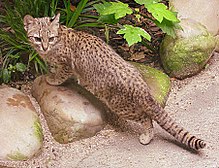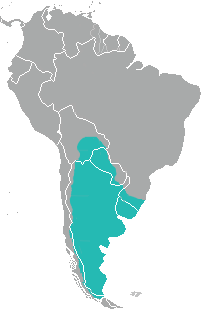Geoffroy's cat
| Geoffroy's cat | |
|---|---|
 |
|
| Scientific classification | |
| Kingdom: | Animalia |
| Phylum: | Chordata |
| Class: | Mammalia |
| Order: | Carnivora |
| Family: | Felidae |
| Genus: | Leopardus |
| Species: | L. geoffroyi |
| Binomial name | |
|
Leopardus geoffroyi (d'Orbigny & Gervais, 1844) |
|
 |
|
| Range of Leopardus geoffroyi | |
| Synonyms | |
|
Oncifelis geoffroyi |
|
Oncifelis geoffroyi
Geoffroy's cat (Leopardus geoffroyi) is a wild cat native to the southern and central regions of South America. It is about the size of a domestic cat. While the species is relatively common in many areas, it is listed as Least Concern on the IUCN Red List because it is widespread and abundant over most of its range.
Geoffroy's cat is about the size of a domestic cat, averaging 60 centimetres (24 in), with a relatively short, 31 centimetres (12 in), tail. This felid weighs only about 2 to 5 kilograms (4.4 to 11.0 lb), though individuals up to 7.8 kilograms (17 lb) have been reported. In general, those found in the southern part of their range are larger than those from the north, and males are larger than females.
Their fur has numerous black spots, but the background colour varies from region to region: in the north, a brownish-yellow coat is most common; farther south, the coat is grayish. As with most wild cats, the fur of the underbelly is paler, being cream-colored or even white. There are dark bands on the tail and limbs, and similar markings on the cheeks and across the top of the head and neck. The backs of the ears are black, with white spots (ocelli). Melanism is common both in the wild and in captivity.
Unusual among cats, Geoffroy's cats have been observed to stand up on their hind legs to scan the surrounding landscape, using their tail as a support. A similar posture is seen in weasels, meerkats and prairie dogs, but not generally in felines.
Geoffroy's cats inhabit the Andes, Pampas (scrubby forest parts), and Gran Chaco landscape. They are found from southern Bolivia to the Straits of Magellan, at elevations ranging from sea level up to 3,300 metres (10,800 ft). They prefer open woodland or scrubland habitats with plenty of cover, but are also found in grasslands and marshy areas. Although they are able to climb trees, they rarely do so, except to leave faeces to scent mark their territory.
...
Wikipedia

